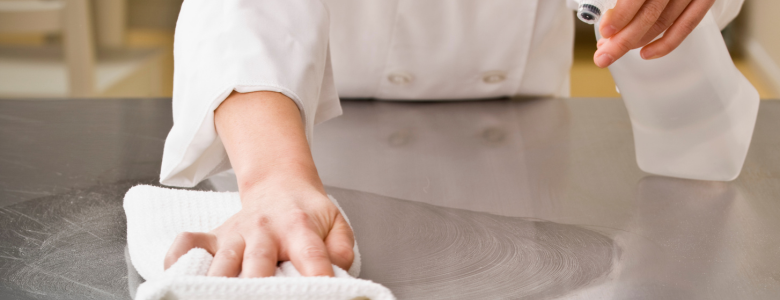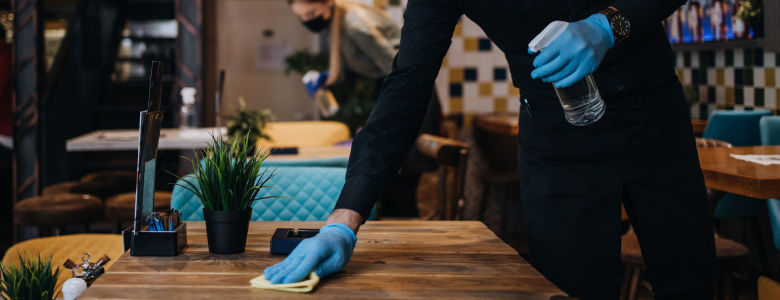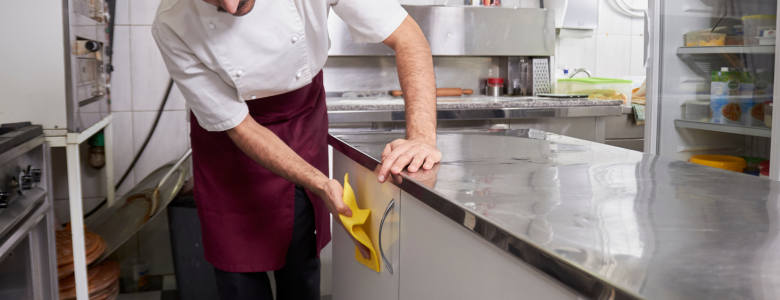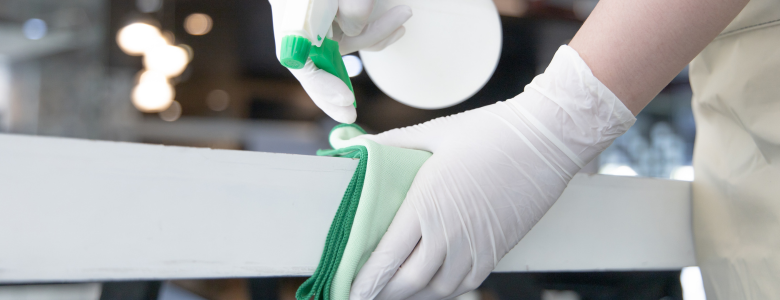
What Are Food Grade Sanitisers Used For? Practical Uses
Keeping food-contact spaces clean and free from harmful bacteria can be challenging. Food safety is crucial, but many people aren't sure about the best practices for sanitising.
These surfaces can harbour dangerous microorganisms without proper sanitisation, leading to foodborne illnesses and contamination. This can pose serious health risks and impact the reputation of any food business.
Thanks to food-grade sanitisers, you can tackle this problem by effectively killing bacteria and other harmful microorganisms. They are specifically formulated to ensure that food preparation surfaces, equipment, and utensils are hygienically clean and safe for food handling.
So, what are food-grade sanitisers used for? Let's find out! Discover more about multipurpose cleaners here!
TL;DR: The Role of Food-Grade Sanitisers
- Purpose of Food-Grade Sanitisers: Safely kills bacteria on food-contact surfaces, equipment, and utensils to prevent contamination and foodborne illnesses.
-
Uses:
- Food Preparation Areas: Clean benches, cutting boards, and utensils after washing.
- Food Storage Areas: Sanitise fridges, pantries, and storage containers to prevent bacteria growth.
- Food Businesses: Maintain hygiene in kitchens, dining areas, and restrooms, meeting health standards.
- Food Processing Facilities: Clean large equipment and surfaces to ensure top-quality, safe food products.
- Benefits: Effective cleaning, reduces germs, is safe with potable water, and prevents contamination.
- Choosing the Right Sanitiser: Match to surface type, ensure detergent compatibility, check rinsing requirements, and confirm effectiveness.
- Common Mistakes: Avoid skipping cleaning, incorrect dilution, insufficient contact time, applying on dirty equipment, ignoring expiry dates, and overuse.
Understanding Food-Grade Sanitisers
 Food-grade sanitisers are chemical sanitisers safe for use on food-contact surfaces, like equipment and utensils. They kill bacteria, reduce surface contamination, and help prevent food poisoning in food businesses. Unlike non-food-grade sanitisers, they are safe for food premises as they achieve a safe level of sanitisation without harmful residues.
Food-grade sanitisers are chemical sanitisers safe for use on food-contact surfaces, like equipment and utensils. They kill bacteria, reduce surface contamination, and help prevent food poisoning in food businesses. Unlike non-food-grade sanitisers, they are safe for food premises as they achieve a safe level of sanitisation without harmful residues.
These sanitisers work by destroying microorganisms like bacteria that cause infectious diseases. They must be used with proper processes: cleaning agents like detergents to remove dirt and grease, then sanitising cleaning solutions at the correct dilution and contact time. Always follow the manufacturer's instructions and let surfaces air dry with paper towels, not tea towels.
Curious about the difference between sanitisers and disinfectants? Find out more about their distinctions here.
Practical Uses of Food-Safe Sanitisers
Food-safe sanitisers are essential in maintaining hygiene and preventing the spread of harmful bacteria in food-related settings. They are used in various areas, from food preparation to storage and processing, to ensure food safety and cleanliness.
Food Preparation Areas
 In Aussie kitchens, food-grade sanitisers are a must. They keep benches, cutting boards, and utensils clean and safe. After washing with detergent, a sanitiser kills any leftover bacteria.
In Aussie kitchens, food-grade sanitisers are a must. They keep benches, cutting boards, and utensils clean and safe. After washing with detergent, a sanitiser kills any leftover bacteria.
This two-step cleaning process is key for food safety. It's not just about looks—it's about zapping those nasty microorganisms you can't see. Always follow the manufacturer's instructions for the best results.
Additionally, items like meat slicers and stab mixers should be sanitised regularly to remove grease and prevent contamination. Ultimately, food grade sanitisers are used in the kitchen to remove surface bacteria and reduce the risk of contamination.
Using the right cleaning solutions is essential to maintaining a spotless and bacteria-free food preparation area. Check out our food-safe commercial cleaners and sanitisers here!
Food Storage Areas
Fridges, pantries, and storerooms need love, too! Food-safe sanitisers help keep these areas free from harmful bacteria. Regular cleaning and sanitising also stop mould and bacteria from growing on shelves and corners, keeping food fresh and safe to eat.
Don't forget about garbage bins and storage containers—they need a good clean as well. A quick wipe with sanitiser can make a big difference in these often overlooked spots.
Proper sanitisation also plays a role in managing food waste. Ensuring that food storage areas are clean and free from bacteria can help extend the shelf life of fresh produce, reducing unnecessary waste.
Food Businesses
 Cafes, restaurants, and takeaways all rely on food-grade sanitisers. They use them on everything from tables and chairs to kitchen gear and toilets. Sanitising is not just about being clean—it's about meeting health standards, too.
Cafes, restaurants, and takeaways all rely on food-grade sanitisers. They use them on everything from tables and chairs to kitchen gear and toilets. Sanitising is not just about being clean—it's about meeting health standards, too.
These businesses often use a combination of hot water, different chemicals, and heat to sanitise properly. The final rinse is crucial to ensure no harmful chemicals are left behind. Good sanitising keeps customers healthy and coming back for more!
It's also best to sanitise dishwasher regularly and ensure proper air drying of utensils to maintain a clean and safe food-handling environment.
Food Processing Facilities
Sanitisers are used everywhere in big food factories. Workers use them to clean floors, walls, and massive pieces of equipment. These places need to be spotless to avoid any chance of contamination.
Workers use different methods, like sprays, foams, and even fog, to reach every nook and cranny. The goal is to knock out any germs that could cause food poisoning or spoilage. It's all about keeping Aussie food products safe and top-notch.
Benefits of Using Food-Compatible Sanitisers
 Using food-compatible sanitisers is key to keeping food facilities safe and clean. They help reduce any infectious disease by eliminating harmful microorganisms. When used properly with hot water, suitable cleaning chemicals, and other processes, they keep surfaces, equipment, and floors free from dirt, grease, and stains.
Using food-compatible sanitisers is key to keeping food facilities safe and clean. They help reduce any infectious disease by eliminating harmful microorganisms. When used properly with hot water, suitable cleaning chemicals, and other processes, they keep surfaces, equipment, and floors free from dirt, grease, and stains.
- Effective Cleaning: Removes dirt, grease, and stains from surfaces.
- Reduces Germs: Sanitises surfaces to safe levels by wiping out harmful microorganisms.
- Safe for Use: Works well with potable water, unlike harsh chemicals like methylated spirits.
- Prevents Contamination: Ensures food premises remain bacteria-free when properly applied.
Sanitisers are crucial for reducing bacteria on food contact surfaces, but are you aware of how professional-grade disinfectants can further enhance hygiene? Discover the benefits of these disinfectants here.
Choosing the Right Sanitisers for Food Contact Surfaces
 Choosing the right sanitiser for food-contact surfaces is vital for effective cleaning and sanitising. The right product will help adequately clean surfaces, equipment, and floors, ensuring safe and hygienic conditions are achieved.
Choosing the right sanitiser for food-contact surfaces is vital for effective cleaning and sanitising. The right product will help adequately clean surfaces, equipment, and floors, ensuring safe and hygienic conditions are achieved.
- Type of Surface: Ensure the sanitiser is suitable for the surface, whether it's a floor, countertop, or equipment.
- Compatibility with Detergents: Choose a sanitiser that works well with the cleaning detergents used.
- Rinse Requirements: Check if the sanitiser needs rinsing or if it’s a no-rinse type.
- Effectiveness: Confirm it can effectively wipe out bacteria and sanitise thoroughly.
Some food businesses prefer diluted bleach solutions to soak items and sanitise surfaces, while others opt for chlorine-based solutions to destroy microorganisms effectively. The choice depends on the specific cleaning needs and regulatory requirements.
Choosing the right sanitiser for your business is crucial. Explore tips for selecting the most suitable product here.
Common Mistakes to Avoid When Using Food-Safe Sanitisers
 When using food-safe sanitisers, it's easy to make mistakes that can affect food safety and cleanliness. Knowing what to avoid can help keep food service locations clean and equipment properly sanitised.
When using food-safe sanitisers, it's easy to make mistakes that can affect food safety and cleanliness. Knowing what to avoid can help keep food service locations clean and equipment properly sanitised.
- Skipping Cleaning: Always clean with detergents before sanitising; otherwise, dirt and grease remain.
- Incorrect Dilution: Follow the manufacturer’s instructions to avoid too much or too little sanitiser.
- Not Allowing Contact Time: Let the sanitiser sit for the recommended time to work effectively.
- Using On Dirty Equipment: Make sure equipment is free of food scraps and recycled matter before applying sanitiser.
- Ignoring Expiry Dates: Old sanitisers lose effectiveness, so check expiry dates regularly.
- Misapplication and Overuse: Avoid applying sanitiser excessively or on the wrong surfaces, as it can leave harmful residues or damage equipment.
Commercial kitchen equipment, door handles, and other surfaces must also be sanitised regularly, as these high-volume touchpoints can easily spread bacteria.
Conclusion
Food-grade sanitisers are essential for maintaining hygiene in food facilities. They effectively kill bacteria on surfaces, equipment, and utensils, reducing the risk of foodborne illnesses. By using these sanitisers according to manufacturer instructions and in the right contexts, you ensure a safer food preparation environment.
For anyone working in food facilities, adopting proper sanitising practices is crucial to keeping food safe and preventing contamination. Remember, effective sanitisation starts with the right products and procedures. Explore StellarChem for professional cleaning solutions today!
Frequently Asked Questions
What is food-grade sanitiser used for?
Food-grade sanitisers kill bacteria on surfaces, equipment, and utensils in food premises, ensuring safe food handling and preventing foodborne illnesses.
Are food-grade sanitisers used after detergent?
Yes, always use a detergent to remove dirt and grease first. Then apply a food-grade sanitiser to disinfect and ensure safe, clean surfaces.
What is the purpose of sanitising food safety?
Sanitising helps reduce the risk of any foodborne illness by killing bacteria and maintaining hygienic food-handling environments in kitchens and food service establishments.
Food grade sanitisers are used in the kitchen to do what?
Food-grade sanitisers are used in the kitchen to kill bacteria after using detergent. This two-step process ensures that food preparation surfaces, utensils, and equipment are thoroughly cleaned and sanitised, reducing the risk of foodborne illnesses.
